(630) 682-4700
2655 Warrenville Road, Suite 225, Downers Grove, IL 60515
Better information about your collection, water, and stormwater systems
Explore ClarityBetter information about your collection, water, and stormwater systems
Explore Clarity
RJN Group, Inc., is an award-winning engineering firm specializing in the asse...
Designing large diameter gravity sewers is challenging. Designing gravity sewers in fully-developed urban areas is even more so.
When the gravity lines exist in a federal levee and must bolster the collection system capacity serving over a quarter of a major metropolitan wastewater service area, you have a perfect storm of engineering design challenges.
This is precisely what happened to the Trinity West Fork Federal Floodway Levee in Fort Worth, Texas when a segment partially collapsed in late 2018.
RJN had only begun designing a parallel sewer relief pipeline in the fall of 2018 when a routine inspection identified that several sinkholes had opened up in the Trinity West Fork Federal Floodway Levee. A site visit by RJN’s Project Manager Chris Brooks, PE, and Tony Sholola, PE, City of Fort Worth Assistant Director of the Water Department, determined that a portion of the existing 48-inch inverted siphon across the Trinity River had partially collapsed, which created the sinkholes. The perfect storm had arrived.
Immediately, all of RJN’s project efforts were redirected to focus on effecting an emergency repair quickly and safely.
The stage was set for an epic engineering challenge as the broken pipeline had to be repaired before further deterioration occurred and with all factors being considered.
Aerial image of the sinkholes and levee topography captured by drones
The sinkholes resulted from exposed flows—due to the top of a 28-foot-long section of pipe breaking and falling into the bottom of the pipeline—undermining the levee structure.
As luck would have it, a few key factors kept the situation from becoming an absolute disaster while providing RJN’s engineers with critical time to develop a viable solution:
While the situation was relatively stable, danger loomed as further pipe collapses could cause a major blockage at any moment, creating a scenario that could have led to sanitary sewer overflows directly into the Trinity River.
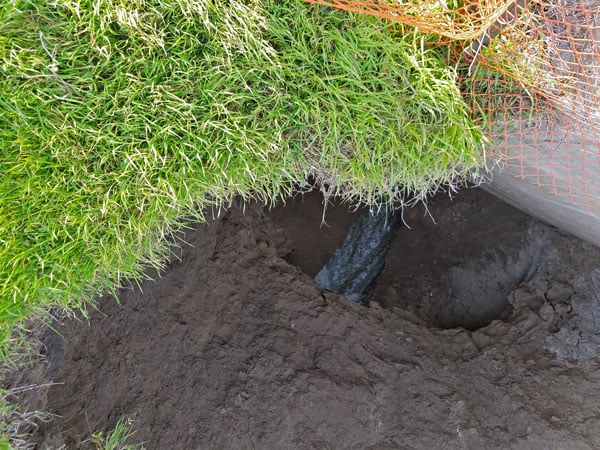
Exposed flows undermined the levee structure near the siphon box, creating two sinkholes.
As you could probably imagine, conducting any work within a federal levee requires a certain degree of equal parts grit and finesse to navigate rigorous permitting and approval processes; but none of that took place with this project.
Due to the time-sensitive nature of this project, drones were used to rapidly gather topographic information, which showed that the levee was quite wide where the break occurred. This meant that open-cut construction could potentially be used without further compromising the levee's integrity. With an imminent environmental threat looming, several preliminary designs were submitted to the USACE and Tarrant Regional Water District (TRWD) for review.
How do you handle diverting a quarter of Fort Worth’s wastewater flows? With a 15 MGD flow diversion and a massive 44 MGD bypass pumping plan.
Planning for the bypass system included reviewing flow data and hydraulic modeling results to target a peak system flow rate. Field testing of a roughly 15 MGD flow diversion using a new pneumatic inflatable plug was also conducted for the existing 72-inch diameter M-245 pipeline. RJN’s hydraulic analysis of the collection system settled on a 44 MGD peak flow bypass design that could provide nearly 70 MGD of temporary system capacity.
This setup facilitated the isolation of all wastewater flows to the existing siphon pipeline, enabling the construction of emergency repairs.
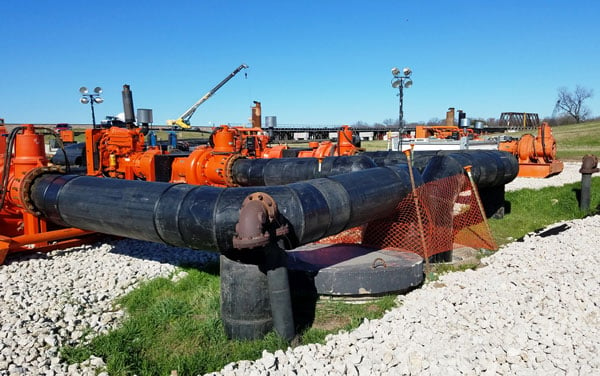 This bypass setup didn’t come easy, however. The bypass system required the construction of two new access manholes along the existing 48-inch siphon on both sides of the Trinity River to discharge the bypass force main pipes and to partially dewater the siphon pipe for safety. Unfortunately, the dewatering manhole had to be added because the downstream siphon box manhole access was too small (18-inches in diameter) to install dewatering pumps into the system. The twin bypass pipes had to be tunneled under the regional concrete trail system.
This bypass setup didn’t come easy, however. The bypass system required the construction of two new access manholes along the existing 48-inch siphon on both sides of the Trinity River to discharge the bypass force main pipes and to partially dewater the siphon pipe for safety. Unfortunately, the dewatering manhole had to be added because the downstream siphon box manhole access was too small (18-inches in diameter) to install dewatering pumps into the system. The twin bypass pipes had to be tunneled under the regional concrete trail system.
The next challenge was identifying a bypass force main discharge location that the USACE would approve. The simplest solution was to create a new discharge point next to the river and located downstream of the collapsed portion of the siphon pipeline to receive the bypass flows. With peak flows accounted for and the structural and construction limitations satisfied, it was time to test the bypass system and then schedule the official flow diversion to break ground on the system repairs.
Levees are significant structures that govern all infrastructure within and around them. Any changes to existing facilities, like the inverted siphon, must be brought into compliance with the applicable codes of the day.
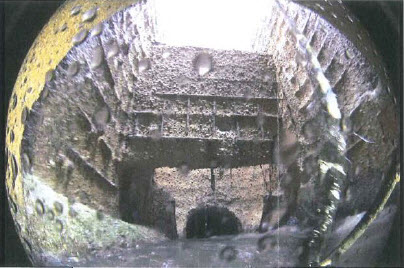
The siphon junction box was severely corroded
Based on RJN’s initial inspection of the levee sinkholes, it was evident that the existing upstream siphon junction box had major corrosion damage and was in immediate need of rehabilitation or replacement. Time to fire up the backhoes, right? Wrong.
The existing siphon box was constructed in 1957, and the levee was then built around it. Because of this, the structure was grandfathered in; however, removing that structure meant that its replacement must meet current standards, which would not allow it to be replaced within the levee footprint. So simply pulling out the existing siphon box, making the pipeline repairs, and reconnecting the existing 72-inch and 48-inch RCP pipes was not an option.
Further complicating matters, the M-245 pipeline curved into the existing siphon box, making its relocation outside of the levee impossible without installing a completely new inverted siphon pipeline across the Trinity River, changing this emergency repair into an emergency pipeline replacement. This meant doubling or tripling the construction timeline, which was not an acceptable solution.
Additionally, the 48-inch siphon pipeline was completely encased in solid concrete with a reinforced concrete cradle. This meant that certain rehabilitation methods to repair the collapsed pipe were not possible due to the extensive excavations that would be required.
Giving credence to Occam’s razor, the simplest solutions are proved as the best. RJN engineers recommended leaving the existing siphon structure in place and constructing a new manhole inside to reconnect the existing pipeline and the repaired segment. This idea was incredibly ingenious as it enabled RJN’s engineers to take advantage of the “grandfathered” structure, allowing for modern wastewater improvements to be made within the levee footprint and floodway.
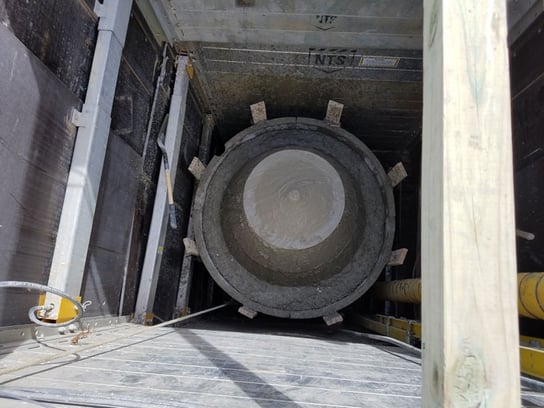
A new manhole was constructed inside of the existing, shored-up siphon box
The existing siphon box had to be temporarily shored up for worker safety. This was accomplished using an aluminum trench box shoring system so that a new Conshield®-treated and epoxy-lined concrete manhole could be safely constructed inside that structure to transition the 72-inch gravity sewer flows into the new 42-inch siphon pipeline replacement. Once these items were in place and the flow diversion plan was fully operational, the manual flow diversion to isolate M-245 was initiated, and emergency repair work was ready to commence.
It was finally time to “fire up the backhoes,” how the equipment was used provided an opportunity to enhance safety while also creating a more functional work zone. With so many moving pieces and entities involved in the project, RJN collaborated with the contractor to develop a detailed safety plan to ensure that every worker got to go home at the end of each day.
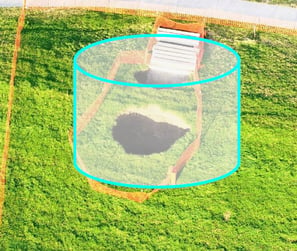
RJN’s original repair plan would use a custom, 32-foot-diameter tunnel liner plate (TLP) shaft installed adjacent to the existing siphon box.
This alternative would minimize the repair's excavation footprint and provide some additional protection to the environment because it would substantively contain any wastewater overflows that might occur. The USACE agreed to the design concept and authorized our team to proceed immediately.
Upon notifying the USACE of this schedule impact, they declared it unacceptable and asked RJN for an alternative.
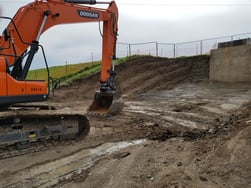 RJN’s project team then took a decidedly “old school” approach by suggesting the deployment of a large excavator and implementing a dynamic trench safety plan. Reluctantly, the USACE agreed and again verbally authorized RJN’s team to proceed with the design and construction plan. With the break occurring 30 feet deep within the levee, stacked trench boxes would typically be required to effect repairs; however, because the levee was extra-wide where the break occurred—nearly double the standard levee width—using limited benched excavations was feasible. Benched excavation enabled work to be completed while only requiring the use of a single trench box.
RJN’s project team then took a decidedly “old school” approach by suggesting the deployment of a large excavator and implementing a dynamic trench safety plan. Reluctantly, the USACE agreed and again verbally authorized RJN’s team to proceed with the design and construction plan. With the break occurring 30 feet deep within the levee, stacked trench boxes would typically be required to effect repairs; however, because the levee was extra-wide where the break occurred—nearly double the standard levee width—using limited benched excavations was feasible. Benched excavation enabled work to be completed while only requiring the use of a single trench box.
Other construction best practices were also utilized to limit environmental impacts, such as installing silt and safety fencing to separate the regional trail system from the pipeline improvement work zone.
Work was wrapped up by utilizing 455 cubic yards of flowable fill, or controlled low-strength material (CSLM), into the levee and 74 cubic yards of CSLM to backfill the old upstream siphon box structure around the new manhole installed inside of it. Using CSLM enabled RJN’s project team to avoid having to rebuild the levee using 6-inch lifts of soil compacted to 95% of optimal compaction using the standard Proctor curves, as the installation and testing would take months to complete.
With the break occurring in the levee, community relations for actual construction efforts were not a factor. However, the bypass setup, laydown areas, and construction ingress/egress were another story. In a vacant lot adjacent to the east-side West Fork Trinity River Floodway Levee and downstream siphon junction box, citizens had established a beloved community garden. Navigating the comings and goings of heavy construction equipment without impacting those gardens required additional and unforeseen coordination with the nearby TRE railroad bridge contractor, our team, the local residents, and regulatory agencies. This effort proved successful as the garden remains intact to this day.
As noted previously, a regional trail system traversed throughout the primary construction zone of this project, requiring adjustments to the force main bypass pipes by tunneling under the concrete trail. This ensured that the community never lost access to this resource.
Lastly, nearby soccer fields required coordination with Fort Worth Parks Department to set up the bypass system adjacent to the nearby soccer fields. Fortunately, there were no conflicts or impacts to the use of those recreational facilities, but RJN’s team kept them informed nonetheless.
While the vast majority of Fort Worth’s citizens were none-the-wiser regarding the break and repairs, community members that frequented the levee were glad to lose an area fixture after the project was completed. It was a known issue that the levee was quite odorous, so during the emergency siphon construction, RJN engineers had an opportunity too good to pass up to design and install odor control measures on the modified siphon box. With the new control measures in place, the community happily lost their most smelly attraction.
The existing inverted siphon structure was built using traditional methods and concepts, resulting in a single barrel pipeline and upstream siphon structure designed with open ventilation and a controlled overflow bypass system allowing for direct discharging into the river. Let us all be thankful for the Clean Water Act of the 70s, which stated that sewage could no longer intentionally be designed to overflow into our waterways. Also, it is important to note that prior to RJN’s repairs, this structure was modified to be incapable of bypassing flows into the river. As part of our design work on this facility, we confirmed that the overflow bypass system had long ago been effectively plugged with concrete and could not bypass flows.
Removing the pipeline from service to conduct a thorough inspection would require a massive, costly bypass setup, so its condition was estimated. However, this didn’t account for turbulence and air pockets that occurred when the flows went from a 72” gravity pipe into a 48” inverted siphon on the other side. In hindsight, the break happened exactly where a trained eye would expect it to occur.
The cost and logistical issues of abandoning the line meant the difference between a $1,137,388 project and a multi-million dollar project. Had RJN’s engineers not been able to come up with an acceptable solution using the grandfathered existing structures, this project would have been several magnitudes more significant. This incident has renewed efforts and demonstrated the need for developing approaches to monitoring, inspecting, and rehabilitating those necessary evils in collection systems known as inverted siphons.
During the trial run for the proposed flow diversion testing, the new pipeline plug exploded after 20 minutes, resulting in a massive sewage geyser and several wet, smelly people observing the flow diversion test. Thankfully, no one was injured.
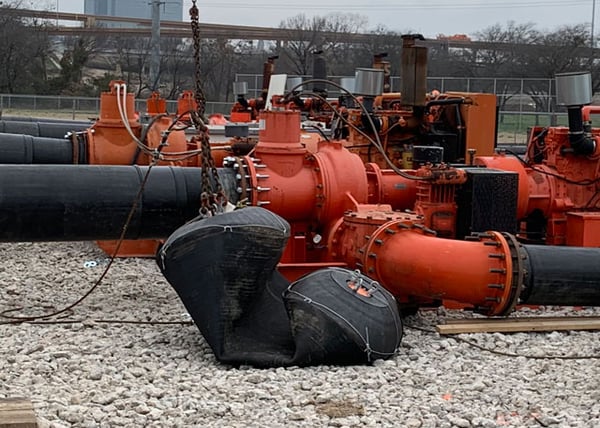
The 14-foot plug burst during bypass setup testing.
This incident highlights the importance of creating and maintaining safety programs for all parties involved in all projects, especially for complex projects such as this one. The setback did delay work several weeks while another plug was ordered.

RJN Group, Inc., is an award-winning engineering firm specializing in the asse...